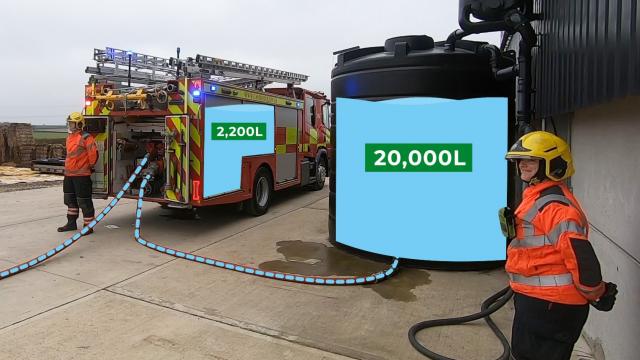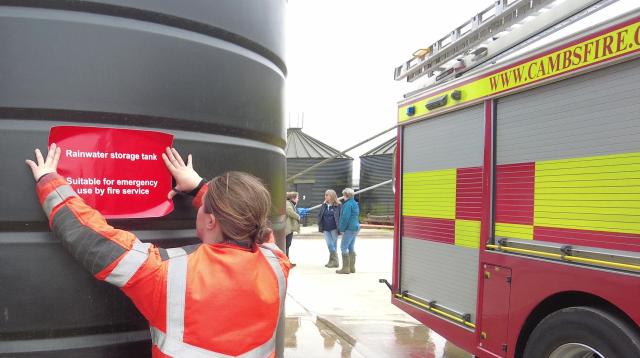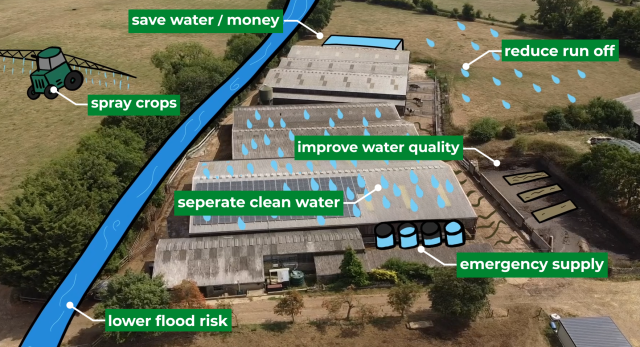Written by Stacey Branson, Farmer & Catchment Sensitive Farming Adviser
"I was in the main farmyard when we got the phone call about the fire. I walked out the farm gate to see flames racing across the neighbour’s wheat field. The wind was changing direction and flames were now heading towards the tinder dry woodland next to our farm and home.
My husband and father-in-law took tractors with cultivators to the field to help create a fire break. I rushed home to get the car and dog, then phoned friends familiar with cattle who could help move them if the wood became engulfed with flames. I also made a plan to save the local box of barn owlets if it came to that."
"The most important help, other than the fire service, came from a plea for help on our local ‘Cambridgeshire Countryside Watch’ WhatsApp group which had around 190 members.
While the fire service struggled to get water to the field due to the distance of the nearest hydrant, the rural community came to our rescue. Local farmers turned up in tractors with cultivators and water bowsers. A straw baling contractor brought leaf blowers, and other countless people (I still don’t know who they all were) helped with fire beaters. It was a huge relief to see our community come together, and I am eternally grateful for those who dropped everything to help prevent the fire spreading."

Cambridgeshire Fire and Rescue demonstrate pumping water from Stacey’s rainwater harvesting tanks. Overlayed graphics show capacity of tanks (20,000L) and engine (2,200L).

20,000 litres of water just sat in the yard
"At the time, the nearest working fire hydrant to our farm was over 2 miles away. The fire service had to create a shuttle moving 2,000L of water per fire engine each trip. Our farm’s rainwater harvesting tanks hold ten times that, but the fire engines didn’t have a way to connect to them. We had 20,000L of water just sat in the yard next to the field - unable to use it while the fire spread.
After the fire I contacted my friend Chelsey McKimmie, a fire officer at the local station. One quiet day she brought a fire engine round to our farm and connected it to our rainwater harvesting tanks with a newly made fitting. It worked. It successfully drew water from the tanks, at the right pressure and without the tank collapsing - we had proved the concept."
Chelsey holds up rainwater harvesting tank stickers provided by NFU.

Catchment Sensitive Farming (CSF), the National Farmers Union (NFU), and Cambridgeshire Fire Service came together to begin a local trial mapping rural water sources.
Chelsey said, “We spoke to lots of people within the fire service, and within farming, to try and establish the best way of getting the fire service, and farming to work together. We now carry adaptors on our frontline fire appliances so we can use the sprayer hoses that sit with the water tanks and tap into them as an emergency water source.”
We’re now encouraging farmers to complete a short form on the fire and rescue service website to register their tanks and sources of water.
This includes a what3words location, the tank’s capacity, sizes of adaptors and sprayer hoses. Once farmers are signed up, they’re sent a sticker to ensure the right tank is accessed in an emergency.
Chelsey hopes the trial’s success will lead to a national roll out, “Eventually all tanks will be on our mobile data terminals in our fire engines, so when we’re looking for a hydrant, it will pop up as an icon.”
Hertfordshire Fire and Rescue has a similar project that has already proved invaluable when fighting a fire at Codicote Quarry.
Station Commander Dave Smith said, “Accessing that water made such a huge difference. Crews tapped into several thousand litres to supplement their water supplies. A bowser was on its way but that takes time, and it was much quicker to be able to tap into this source.”
‘Having these tanks is certainly saving us money’
Rainwater harvesting tanks can also be invaluable to farms in times of drought. Officials have recently called water shortages in the UK “nationally significant”, putting more strain on farm businesses. Rainwater harvesting tanks have many benefits to farms, they:
- Provide a reliable water source if supply is cut off in periods of drought or low pressure
- Improve local water quality and reduce slurry volumes by separating clean and dirty water in the yard
- Prevent soil erosion and loss of nutrients by reducing runoff
- Slow the flow into local water bodies helping flood mitigation
- Save money on bills by using them to water livestock, spray crops, and wash equipment

"Having these tanks is certainly saving us money, we’re on a water meter spraying many times over the year - that’s a significant saving. I hope this trial with the Cambridgeshire Fire Service and NFU will encourage mores farms to install rainwater harvesting tanks. It’s great for businesses, the local environment, and in the event of a fire it could ultimately save farms, livestock, crops, wildlife, local habitat and lives."
Catchment Sensitive Farming (CSF) is a Defra-funded programme giving free and confidential advice to farmers. Your local CSF adviser can see if rainwater harvesting is right for your business and explore the funding options available. To contact your local team, visit farmingadviceservice.org.uk/csf/get-in-touch
CSF gives free and confidential advice to farmers. It is led by Natural England, in partnership with Defra, the Environment Agency, Farming Advice Service and the Forestry Commission.

